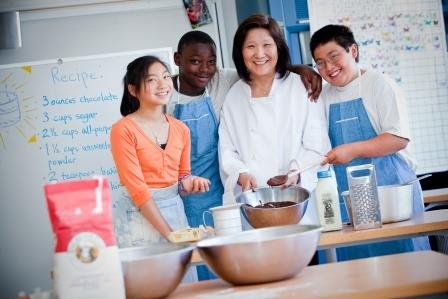
Cook with Students
Cooking with students educates and empowers students to make nourishing food choices through hands-on learning. Cooking is a life skill and supports math, science, language, social emotional development, physical development (fine motor skills) and cognitive development.
Cooking with Students
Link to this section
NOTE: With COVID-19-
- Follow recommendations from San Francisco Department of Public Health
- Choose recipes that can be cooked with each student having their own ingredients
- Try simple recipes or tasting activities in remote learning
Before Cooking with Students
Before cooking with students:
- Check for allergies [check with parents/caregivers, check Allergy Emergency Care Plans, ask School District Nurse]
- Teach a lesson on handwashing and universal precautions.
Hand washing poster: English/Spanish/Chinese (pdf)
Demonstrate proper knife use, even if students are using plastic cutlery.
Choose a Recipe
Choose a recipe:
Match the recipe to your students’ developmental level. See Kitchen Skills at Every Age
Think of cooking as a nutrition education/health lesson and choose nourishing recipes: www.eatfresh.org is an excellent resource:
- Recipes available in English, Spanish, Chinese
- Search feature by culture, ingredient, “kid-friendly”, limited cooking equipment
- For young students, do not make a community dish; each student should make their own recipe--especially with cold, uncooked dishes
Choose recipes that represent the communities of the students in your class or have students bring in family recipes.
Cooking Equipment
Link to this section
All Kitchens
- Cleaning equipment: Kitchen towels or paper towels, dishwashing liquid, sponges, disinfecting spray
- First Aid Kit
- Access to handwashing, hand sanitizer
- Consider keeping your equipment in a large plastic bin with a lid. This makes storing easy and convenient.
Level 1
- Skills: washing, measuring and mixing
- Recipe Ideas: Yogurt parfaits, trail mix, fruit salad, vegetable salads/dressings
- Equipment:
- Measuring equipment: Dry measuring cups, liquid measuring cups, measuring spoons
- Glass jars
- Reusable cups, plates, and cutlery, napkins
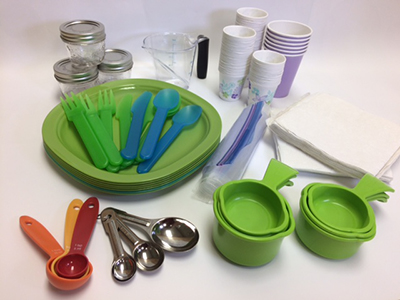
Level 2
- Skills: washing, mixing, measuring, cutting, slicing, blending, pouring
- Recipes: Veggie roll ups, fruit kabobs, smoothies, fruit/herb infused “spa” water, simple sandwiches, fresh salsas
- Equipment:
- Colander/Strainer
- Mixing bowls: (large, medium, small)
- Knives-See recommendations above
- Cutting Boards/large plates
- Water Pitcher
- Apple slicer
- Rubber Spatulas
- Blender
- Wooden round edged coffee stirrers (Instead of pointed wooden skewers)
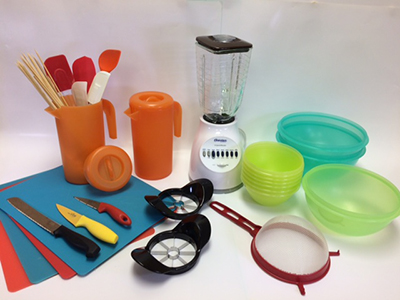
Level 3
- Skills: washing, mixing, measuring, cutting, slicing, baking, grating, flipping, spreading
- Recipes: English muffin pizzas, Stone Soup, quesadillas,
- Equipment:
- Ladle
- Tongs
- Colander/Strainer
- Cheese grater
- Tongs
- Wooden Spoons, spatula/flipper
- Can Opener
- Cutting Boards
- Knives
- Bowls (Large, medium, small)
- Oven mitts
- Electric fry pan
- Single burner electric coil
- Pots, pans, skillet
- Use of oven or portable convection oven
- Parchment paper
- Baking pan
- Sheet pan
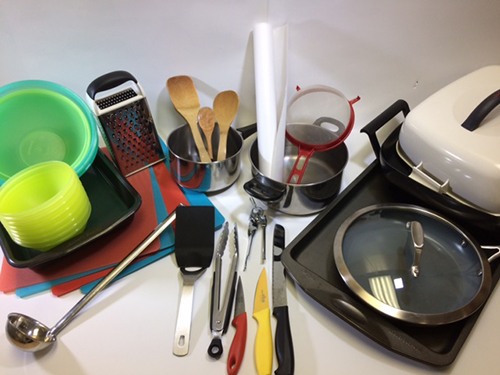
Recipes
Link to this section
The following recipes can be modified for all groups.
Strawberry Banana Smoothies
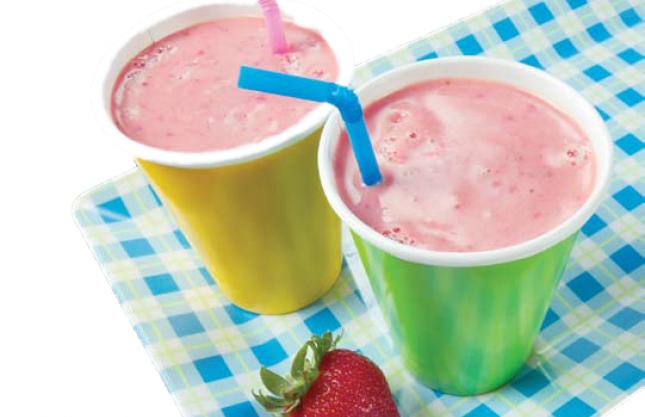
One Recipe, Three Grade Levels: Strawberry Banana Smoothies
Serves: 2 full portions; 6 smaller portions
Ingredients
Serves 6 small portions
- ½ banana, peeled and sliced
- 1 cup berries, frozen
- ½ cup lowfat milk or unsweetened non dairy milk or silken tofu
- ½ cup 100% orange juice
Equipment
- Knife
- Cutting board
- Measuring cup
- Blender
- Mixing Spoon
- Serving cups
Method
- Place all ingredients in a blender container . Put lid on tightly .
- Blend until smooth . If mixture is too thick, add ½ cup cold water and blend again .
- Pour into 2 glasses and serve.
PK - Grade 1
Each student uses a plastic fork and paper plate to mash their own fruit and then scrape into a paper cup. Adults can pour liquid ingredients into the cups, while students “blend” with their forks.
Grade 2 - 5
- Students work in small groups, create smoothies while learning about nutrients and creating short commercials.
- Lesson plan
Middle School & Beyond
- Research the differences between USDA MyPlate and Harvard’s Healthy Eating Plate.
- Plan a smoothie school fundraiser researching ingredient costs and estimating revenue.
This page was last updated on November 8, 2023

